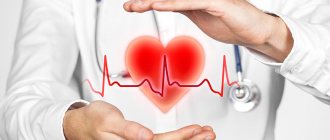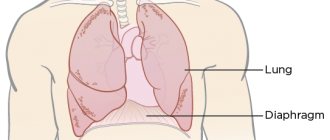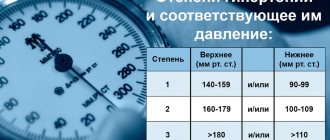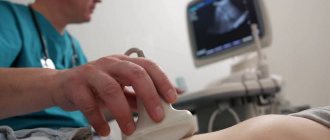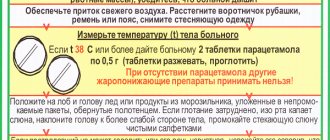Hypertension is a pathology of the heart and blood vessels, manifested by increased blood pressure. In the pathogenetic mechanism of the formation of the disease, disturbances in the neurohumoral, central and renal mechanisms of blood pressure regulation play a huge role.
Arterial hypertension is one of the fundamental risk factors for the development of potentially fatal diseases - stroke and heart attack. That is why it is important to know why hypertension occurs, how it is diagnosed and what medications are used in treatment.
Development of hypertension
The essence of the disease is frequent and/or persistent increase in blood pressure.
The origin of the disease is still unknown, but there is disruption of the heart and increased vascular tone. Depending on the level of high blood pressure, there are three degrees of severity of hypertension: 1 degree (mild, soft) - the patient’s pressure is in the range from 140/90 to 159/99; 2nd degree (moderate) - pressure ranges from 160/100 to 179/109; Grade 3 (severe) - blood pressure above 180/110.
Hypertension with predominant heart damage without heart failure
Michael
1674 views
November 19, 2020
Hello! 36 years old, 83 kg, 192 cm, male Complaints: periodic pressure surges, underwent examination, verbally the doctor said that carvedilol should be increased from 12.5 to 25 once a day. When I read the diagnosis at home, I was stunned by “hypertension with primary damage to the heart without heart failure” and Possibly an enlargement of the left atrium Interatrial conduction disturbance The phenomenon of early ventricular repolarization How severe is the deviation from the norm? ——=======Stress echocardiography=======—— Initially: blood pressure 130/80 mmHg, heart rate 84 beats per minute During the test, a load of 12.7 METs was achieved. Duration of the test was: 12 min 29 sec At the height of the load, the heart rate was recorded: 166 beats per 1 min, 90% of the maximum heart rate, blood pressure 160x80 mm Hg. Reason for stopping the test: achievement of submaximal heart rate Load tolerance according to the test results: high Blood pressure response to load: adequate No significant ischemic changes in the ECG were noted Anginal attack: not recorded Echoradiography data Before load: LV walls with normal contractility After load: No disturbances in regional contractility revealed Conclusion: Test negative ——=======Electrocardiogram=======—— Heart rate: 60 beats per minute PQ: 141 ms QRS: 101 ms QT: 380 ms QTc: 388 ms Alpha angle: 37 Grad Regulation EOS: Intermediate ST: I 21 μV V1 -88 μV II 6 μV V2 121 MMV III -29 μV V3 155 μV AVR -4 μV v4 AVL 27 μV V5 197 197 μV AVF -11 μV Conclusion Conclusion : Sinus rhythm with heart rate 60/bpm Incomplete blockade of PNPG Possibly enlarged left atrium Impaired interatrial conduction Phenomenon of early ventricular repolarization ——=======Echocardiographic study (with calculations)=======—— Aorta diameter in the area of the sinuses of Valsalva 38 mm; diameter of the ascending aorta 32 mm; the walls are not changed. The left atrium diameter is 39 mm; indLP 1.81 cm/m2; LA volume 61 ml; LA volume index 28.24 ml/µV; MPP is not changed Left ventricle. MZhP 9 mm, CDR 50 mm, CL 10 mm, CDR index 2.31 cm/m2, FROM 0.38, EDV (Th) 118.24 ml, MM 169.80 g, IMM 78.61 g/m2 KDOV-mode 122 ml, EDC v-mode 46 ml , EDV index 56.48 ml/m2, ESV index 21.30 ml/m2, Simpson EF 62%, kinetics unchanged Right ventricle paramternal position 31 mm; 4-chamber 31 mm Right atrium area 17.3 cm2 Pulmonary artery 20 mm, estimated systolic pressure 23 mm Hg Inferior vena cava: 20 mm, burning on inspiration: >50% Aortic valve leaflets are not changed; Vmax 1.15 m/s, dPmax 5.32 mm Hg, no regurgitation The mitral valve leaflets are not changed; Ve 0.81 cm/s, Va 0.55 cm/s, Ve\Va 1.47, Tdec 137 ms, no regurgitation Tricusidal valve leaflets are not changed, regurgitation is valvular dPtr 17.74 mm Hg Pulmonary valve Vmax 0.73 m/s, dPmax 2 ,14 mm Hg, valvular regurgitation Description of the study: The heart chambers are not dilated. The walls of the LV are not thickened, the calculated values of the myocardial mass are not increased. Global contractility of the LV is not impaired. No zones of violation of regional contractility have been reliably identified. Normal diastolic function and LV filling pressure. E/Em-4.56 RV contractility according to TDI (TAVS = 14.0 cm/s) is preserved. TAPSE = 2.4 cm The IVS and IVS are located intact. During CDI mapping, no convincing evidence for transseptal blood shunting was obtained. The root, ascending section and arch (33 mm) of the aorta are not dilated, the walls are not changed. The pulmonary trunk is not dilated. The aortic valve is tricuspid, its crescents are not changed. Blood flow in the AC and in the LVOT is not accelerated. SV (LVOT) ~ 74ml. The leaflets of the mitral valve and tricuspid valves are not imzened. Mitral regurgitation is valvular. Tricuspid regurgitation, valvular. Estimated MPAP is not increased The amount of fluid in the periocardial cavity is not increased
The question is closed
aorta
maximum heart rate
estimated value
Symptoms of hypertension
In the absence of treatment and secondary prevention, the disease progresses. Depending on the damage to target organs, they are distinguished: Stage I. Typically, but not necessarily, characterized by a mild and intermittent increase in blood pressure without target organ damage. However, it is quite possible for both a crisis and a completely asymptomatic course of the disease. In addition to high blood pressure, the patient may be concerned about:
- headache;
- decreased performance;
- tendency to fluid retention;
- fast fatiguability.
Stage II is characterized by the appearance of signs of damage to target organs (heart, kidneys and brain, as well as blood vessels, including the eyes, which may be accompanied by the appearance of new symptoms and complaints, as well as according to additional laboratory and instrumental studies:
- pain in the “heart area”;
- dizziness;
- visual impairment;
- the appearance of edema;
- memory loss;
- shortness of breath on exertion.
Stage III - complicated hypertension. The main sign of the course of the disease at this stage is severe damage to target organs with thrombosis, including heart attacks and strokes, accompanied by the following symptoms:
- hand tremors;
- noise in the head or ears;
- significant memory loss;
- nausea, vomiting;
- persistent visual impairment;
- various heart disorders.
Most of these symptoms are stable and usually progress, reducing performance.
Symptoms
Headache is perhaps the most common manifestation of high blood pressure, or, as it is called, hypertension. It is associated with spasm of cerebral vessels. Sometimes other symptoms are observed: noise in the ears (such as a hum or ringing), flickering of “spots” or “sparkles” in the eyes, blurred vision. This is also due to impaired blood circulation in the areas of the brain responsible for sound and color perception, and in addition, the blood supply to the actual sound-receiving devices of the ear and the light-receiving structures of the eye is also disrupted. Shortness of breath may occur, as well as chest pain (this pain is associated with impaired blood supply to the heart muscle - the myocardium - due to the same vascular spasm).
Diagnosis of hypertension
Diagnosis of hypertension is performed by a cardiologist. To identify the disease and individualize treatment, the following methods are used:
- dynamic blood pressure measurement;
- laboratory tests - clinical and biochemical blood tests, general urine analysis;
- electrocardiography, including in the form of Holter monitoring;
- ultrasound examinations: heart, kidneys and other organs;
- Dopplerography (ultrasound of blood vessels).
Causes of the disease
One of the main and primary reasons is heart and vascular disease. The second most popular reason is obesity, especially at high risk.
Obesity can lead to hypertensive heart disease
Also, the causes of the development of the disease can be:
- Excessive consumption of alcoholic beverages;
- Poor nutrition (large amounts of salt in the diet, fatty, fried and smoked foods);
- Sedentary lifestyle;
- Hard work in hazardous work;
- Frequent stress and nervous tension;
- Lack of rest and sleep;
- Atherosclerotic vascular lesions;
- Endocrine system disorders.
The cause may also be genetic predisposition, serious hormonal imbalances and disorders in the endocrine system.
Treatment of hypertension
To treat the disease, both drug and non-drug therapy are used. Hypertension medications are aimed at preventing high blood pressure. The doctor also recommends lifestyle changes, such as a special diet or moderate exercise. In our clinics on Gorokhovaya St., 14/26
(metro station Admiralteyskaya, Admiralteysky district) and on
Varshavskaya st., 59
(metro station Moskovskaya, Moskovsky district) there are
therapists
and
cardiologists
who will diagnose and draw up a suitable treatment plan for hypertension.
You can make an appointment by calling 493-03-03 or on our website. Make an appointment
Predisposing factors
- excessive consumption of salt (more precisely, sodium, which is part of salt),
- atherosclerosis (these two diseases seem to reinforce each other and often go together),
- smoking,
- excessive drinking,
- increased body weight - obesity
- physical inactivity (that is, a sedentary lifestyle).
Treatment of hypertension involves the correction of all risk factors a person has. Sometimes this alone is enough to significantly reduce blood pressure.
treatment of hypertension When measuring blood pressure, doctors examine two parameters - the upper (systolic pressure) and the lower (diastolic). With some degree of convention, we can say that the main contribution to the first is the strength of heart contractions, and the second is supported by vascular tone. Therefore, when prescribing treatment, doctors are guided by which pressure - systolic or diastolic - is more elevated. In the first case, you need to “slow down” the heart a little, and in the second, you need to dilate the blood vessels.
Hypertension is dangerous because severe or constant vasospasm causes insufficient blood flow to vital organs - the heart, brain and kidneys. If there is excessive spasm of the arteries or if there are atherosclerotic plaques in the vessels, blood may completely stop flowing through the artery, and then a sharp circulatory disorder may occur. This is how stroke and myocardial infarction develop.
Possible risks
The most common disorder is congestive heart failure. It develops, as a rule, due to the lack of correct treatment. In addition, the disease can cause severe swelling throughout the body. This further increases the load on the heart, which is already exhausted.
The vessels become fragile, brittle and are unable to ensure proper blood circulation. This most often leads to a hypertensive crisis, heart attack, stroke and often sudden death.
Heart attack and stroke occur suddenly. It is important to provide first aid in time to save life.
Preventive measures
The best prevention is diet. To prevent the onset of a disease or avoid complications of an existing one, you need to carefully monitor your diet. Food should be healthy, rich in vitamins and microelements. You should not eat fried, salty, fatty or fast food products. In addition, you must:
- To refuse from bad habits.
- Monitor the daily volume of fluid consumed (no more than 1.2 liters per day).
- Limit the amount of salt or completely eliminate it from the menu.
- Avoid stressful situations, overwork and physical overload.
- Be in the fresh air more often and normalize your sleep pattern.
In heart failure, the prognosis can be either positive or fatal. The most important thing is to see a doctor in time. In this case, the outcome will be favorable, because the correct prescription will help to begin a course of treatment in a timely manner and protect the heart, as well as brain cells, from “death.”
Causes
Hypertensive heart disease develops in response to increased demands for blood supply to organs and tissues related to the systemic and/or pulmonary circulation. Accordingly, a distinction is made between systemic (left ventricular) and pulmonary (right ventricular) hypertensive heart disease. The first of them is associated with systemic hypertension, i.e. an increase in hydrostatic pressure in the system of arteries of the great circle, and the second - pulmonary hypertension, i.e. an increase in blood pressure in the vessels of the pulmonary circulation.
Forecast
It is determined by the presence and severity of organ damage associated with arterial hypertension - cerebrovascular and coronary insufficiency, hypertrophy and dilatation of the heart, and the development of arteriolonephrosclerosis. With inadequate treatment, the progressive nature of hypertension leads to heart failure and (or) renal failure, which can cause death in patients.
Significant arterial hypertension increases the risk of hemorrhagic stroke, as well as myocardial infarction (in patients with coronary heart disease), which can also be fatal or lead to disability. Systematic adequate antihypertensive therapy significantly improves the vital prognosis and prolongs the working capacity of patients, significantly reducing the incidence of hemorrhagic strokes and slowing down the development of cardiac, renal, and, according to some data, coronary insufficiency.
Drawing conclusions
Heart attacks and strokes are the cause of almost 70% of all deaths in the world. Seven out of ten people die due to blockages in the arteries of the heart or brain.
What’s especially scary is the fact that a lot of people don’t even suspect that they have hypertension. And they miss the opportunity to fix something, simply dooming themselves to death.
- Headache
- Increased heart rate
- Black dots before the eyes (floaters)
- Apathy, irritability, drowsiness
- Blurred vision
- Sweating
- Chronic fatigue
- Swelling of the face
- Numbness and chills in fingers
- Pressure surges
Even one of these symptoms should give you pause. And if there are two of them, then have no doubt - you have hypertension.
How to treat hypertension when there are a large number of medications that cost a lot of money?
Most medications will do no good, and some may even be harmful! At the moment, the only medicine that is officially recommended by the Ministry of Health for the treatment of hypertension is Hyperten.
Until February 26.
The Institute of Cardiology, together with the Ministry of Health, is conducting the “
Kherson without hypertension
” program.
Within the framework of which the drug Hyperten is available FREE OF CHARGE
to all residents of the city and region!
Well, I don’t know, but for me most drugs are complete garbage, a waste of money. If only you knew how much I’ve already tried... Only Hyperten helped normally (by the way, you can get it almost free under a special program). I took it for 4 weeks, and after the first week of taking it I felt better. 4 months have passed since then, my blood pressure is normal, I don’t even remember about hypertension! Sometimes I drink the product again for 2-3 days, just for prevention. I actually found out about him by accident, from this article..
Treatment
Various antihypertensive drugs are used for treatment. It should be remembered that only a doctor should prescribe medication. If hypertension is secondary, then first of all it is necessary to treat the underlying disease, and taking antihypertensive drugs will be purely symptomatic.
Patients diagnosed with arterial hypertension must radically change their lifestyle. In medicine, this is called non-drug therapy. In the initial stage of this disease, these measures will be sufficient. These methods include:
- reducing salt intake. Table salt retains fluid in the body, which leads to edema and, as a result, hypertension;
- rejection of bad habits. Smoking and alcohol lead to vasoconstriction, which also leads to increased blood pressure;
- getting rid of excess weight; with obesity, there is an accumulation of bad cholesterol in the body, which contributes to blockage of blood vessels;
- increase in physical activity. Exercising helps saturate the blood with oxygen, strengthens the body, and has a beneficial effect on all organs and systems of the body.
Symptoms
Sometimes the only manifestation of heart disease, hypertension, for many years is an increase in blood pressure, which makes early recognition of the disease difficult.
The complaints with which patients consult a doctor in the early stages of the disease are nonspecific: fatigue, irritability, insomnia, general weakness, and palpitations.
Later, most patients begin to complain of periodic, then frequent headaches, usually in the morning, such as a “heavy head”, occipital localization, worsening in the horizontal position of the patient, decreasing after walking, drinking tea or coffee. This kind of headache, characteristic of patients with hypertension, is sometimes observed in people with normal blood pressure.
As hypertension progresses, patients' complaints reflect acute hemodynamic disorders due to the appearance of hypertensive crises, and in the period of organ damage, complaints associated with the formation of complications - dyscirculatory encephalopathy (DEP), angioretinopathy with visual impairment, renal failure, etc. d.
The course of hypertension is characterized by stages in the development of arterial hypertension and symptoms of regional circulatory disorders. Taking this into account, various clinical classifications are proposed, distinguishing its stages, based on the dynamics of both several or even one sign - elevated blood pressure (for example, distinguishing the stages of labile and stable hypertension), and a set of clinical manifestations correlated with the occurrence and progression of complications.
